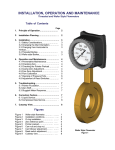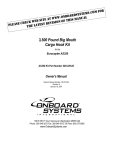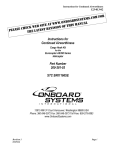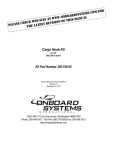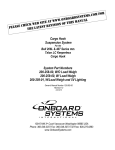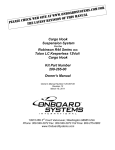Download 120-120-00 - Onboard Systems International
Transcript
Owner’s Manual for the 3.5KK Talon LC Hydraulic Cargo Hook Kits on the BO-105S and BO-105LS A-3 Helicopter System Part Numbers 200-302-00 200-387-00 Owner's Manual Number 120-120-00 Revision 5 August 17, 2012 13915 NW 3rd Court Vancouver Washington 98685 USA Phone: 360-546-3072 Fax: 360-546-3073 Toll Free: 800-275-0883 www.OnboardSystems.com This page intentionally left blank. RECORD OF REVISIONS Revision Date Page(s) 0 02/20/06 All 1 04/04/07 Reason for Revision First Issue Section 1, 2 Updated instructions to reflect hydraulic system being & 3 and TOC shipped dry. Updated warnings, cautions and notes to current format. Updated part numbers and figures to new master cylinder design. 2 06/26/07 1-2, 2-5, 2-8, 2-9 Added spiral wrap (P/N 590-013-00) to BOM. Added instructions to page 2-5 to install spiral wrap over hydraulic hose. Clarified installation instructions and corrected part number for spiral wrap (page 2-8 and 29). 3 06/30/11 All Added kit P/N 200-387-00 and BO-105LS A-3 model. 4 01/25/12 1-2 Updated design load for kit P/N 200-387-00 to 3000 lbs. 5 08/17/12 1-2, 2-9 Adjusted quantities of Adel Clamps to reflect new slave cylinder hose, updated Figure 2.2.2 to reflect usage of Adel Clamps. Register Your Products for Automatic Notifications Onboard Systems offers a free notification service via fax or email for product alerts and documentation updates. By registering your Onboard Systems products at our website, we will be able to contact you if a service bulletin is issued, or if the documentation is updated. You can choose to receive notices on an immediate, weekly, or monthly schedule via fax, email or both methods. There is no charge for this service. Please visit our website at www.onboardsystems.com/notify.php to get started. i This page intentionally left blank. CONTENTS Section 1 General Information Introduction, 1-1 Explanation of Signal Words and Symbols, 1-1 Bill of Materials, 1-2 Specifications, 1-2 Section 2 Installation Instructions 2.1 2.2 2.3 2.4 2.5 2.6 Master Cylinder Assembly Installation, 2-2 Cargo Hook Installation, 2-8 Installation Check-out, 2-11 Component Weights, 2-11 Paper Work, 2-11 Filling Hydraulic Release System, 2-12 Section 3 Cargo Hook Operation Instructions Operating Procedures, 3-1 Cargo Hook Loading, 3-2 Cargo Hook Rigging, 3-3 Section 4 Maintenance Instructions for Returning a System to the Factory, 4-1 Section 5 Certification FAA STC, 5-1 Transport Canada Approval, 5-3 ANAC Approval, 5-4 EASA STC, 5-6 This page intentionally left blank Section 1 General Information Introduction The P/N 200-302-00 Cargo Hook Kit is approved for installation on the BO105S model helicopter equipped with a suspension system installed per American Eurocopter STC SH286NE and the P/N 200-387-00 cargo hook kit is approved for installation on a BO-105S or BO-105LS model equipped with a suspension P/N 117-80127. These kits replace the cargo hook, an adapter link assembly, the manual release cable and an external electrical release wire harness on the existing cable type suspension system. They utilize the existing cable suspension and internal electrical wiring. The P/N 200-302-00 and P/N 200-387-00 kits are identical except for the adapter link assembly. The adapter link assembly serves to connect the cargo hook to the cable suspension shackles and is narrower in kit P/N 200387-00 to accommodate the shackles on the Siren suspension. Explanation of Signal Words and Symbols The following definitions apply to the symbols used throughout this manual to draw the reader’s attention to safety instructions as well as other important messages. Indicates a hazardous situation which, if not avoided, will result in death or serious injury. Indicates a hazardous situation which, if not avoided, could result in death or serious injury. Indicates a hazardous situation which, if not avoided, could result in minor or moderate injury. Draws the reader’s attention to important or unusual information not directly related to safety. Used to address practices not related to personal injury. General Information 1-1 Bill of Materials The following items are included with the Cargo Hook Kits, if shortages are found contact the company from whom the system was purchased. Part No. Description 232-211-00 232-503-00 232-208-01 232-218-00 235-128-00 512-024-00 215-169-00 512-010-00 510-102-00 510-042-00 510-391-00 512-021-00 512-028-00 512-029-00 590-013-00 120-120-00 121-029-00 123-022-00 Cargo Hook/Link Assembly Cargo Hook/Link Assembly Master Cylinder Assembly with Plumbing Hook Retainer Sling Assembly Disconnect Bracket Adel Clamp AS350 Indicator Light Placard Adel Clamp Nut, 10-32 Washer, #10 Screw Adel Clamp 90 Deg. Angle Bracket Ty-wrap Spiral Hose Wrap Owner’s Manual RFMS Instructions for Continued Airworthiness Quantity 200-302-00 1 1 1 1 4 1 8 7 7 7 1 3 1 6 ft. 1 1 1 Quantity 200-387-00 1 1 1 1 4 1 8 7 7 7 1 3 1 6 ft. 1 1 1 Specifications Table 1.1 System Specifications Design load (P/N 200-302-00) Design load (P/N 200-387-00) Design ultimate strength (P/N 200-302-00) Design ultimate strength (P/N 200-387-00) Unit weight P/N 200-302-00 Unit weight P/N 200-387-00 2645 lb. (1200 kg) 3000 lb. (1360 kg) 9920 lb. (4500 kg) 11250 lb. (5103 kg) 6.2 lbs (2.8 kg) 5.9 lbs (2.7 kg) Table 1.2 P/N 528-028-00 Cargo Hook Specifications Design load Design ultimate strength Electrical release capacity Mechanical release capacity Electrical requirements Minimum release load Unit weight Mating electrical connector 3,500 lbs. (1,587 kgs.) 13,125 lbs. (5,952 kgs.) 8,750 lbs. (3,968 kgs.) 8,750 lbs. (3,968 kgs.) 22-32 VDC, 6.9 – 10 amps 0 pounds 3.0 pounds (1.35 kg.) PC04A8-2P Load capacities given are for the equipment described only. Loading limits for your particular helicopter model still apply. Consult your flight manual. 1-2 Installation Instructions Section 2 Installation Instructions These procedures are provided for the benefit of experienced aircraft maintenance facilities capable of carrying out the procedures. They must not be attempted by those lacking the necessary expertise. General preparation: Remove lower belly panels as necessary to access the areas in which the hose is to be routed. If the helicopter currently has the OEM cargo hook kit installed, remove the following:* Cargo hook and its associated mounting brackets from the suspension External wire harness The entire mechanical release cable from the cargo hook up to and including the T-handle in the cockpit. * The 200-302-00 and 200-387-00 cargo hook kits use the helicopter’s existing internal wiring and cable suspension. Retain the hardware used to fasten the cargo hook mounting brackets to the suspension shackles and the hardware to fasten the adel clamps to the suspension cables. Plug the hole in the floor through which the T-handle was installed. This hole will not be used. Installation Instructions 2-1 2.1 Master Cylinder Assembly Installation The hydraulic release system is supplied dry. It is recommended that the system be filled and bled on the bench before installing on the helicopter. Refer to section 2.6 for filling and bleeding instructions. The Master Cylinder Assembly (P/N 232-208-01) installation consists of installing the master cylinder on the collective in the cockpit, and routing the attached hose to a bracket to be installed near the right forward suspension cable. Observe the following precautions (ref. Figure 2.1.1) when routing the hydraulic hose. Use care to avoid kinking the hose. Recommended minimum hose bend radii is 1 inch. Avoid abrupt change in direction of the hose just outside the end fittings. Provide smooth transitions where possible. Verify that the hose routing is clear of and cannot be deflected into chafe points. Figure 2.1.1 General Hose Routing Practices Maximize bend radii Use adel clamp and bracket (shown), ty-wraps, or other suitable means to secure hose at various points. Suspend clear of if possible or add anti-chafe strip. X X Provide as smooth a transition as possible at end fittings 2-2 Installation Instructions 2.1 Master Cylinder Assembly Installation continued Install the Master Cylinder w/ Fixed Plumbing (P/N 232-208-01) per the following: Mount the Master Cylinder Assembly to the collective stick with the Clamp Half (P/N 290-912-00) and two screws (P/N 510-390-00) (provided pre-assembled on the assembly), in the location illustrated below. Figure 2.1.2 Release Lever Installation Master Cylinder Assembly Bracket Collective Fwd View Looking Down Between Forward Seats Remove the bellows at the base of the collective and route the hose down through the hole in the cabin floor through which the collective electrical wire harness is routed. Take care during installation to avoid kinking the hose. Secure hose with adel clamps (P/N’s 512-010-00 and 512-021-00) as shown below, using hardware provided. Add sufficient loop (as shown below) between the adel clamps to account for full movement of collective. Figure 2.1.3 Hydraulic Hose Routing Leave sufficient loop here to account for full movement of collective. Adel Clamp P/N 512-010-00 Existing collective wire harness. Fwd Adel Clamp (P/N 512-010-00) Adel Clamp (P/N 512-021-00) A A Hydraulic Hose Section A-A Installation Instructions 2-3 2.1 Master Cylinder Assembly Installation continued Underneath the cabin floor the hose is routed aft and outboard to the right forward suspension cable attach point. Figure 2.1.4 is an overview of the routing. Figure 2.1.4 Fixed Hydraulic Release System Installation Overview Master Cylinder Assembly See Figure 2.1.5 Collective Quick Disconnect Coupling Forward Aft of the hole in the cabin floor route the hose through existing holes in the airframe as shown below and then secure per Figure 2.1.6. Figure 2.1.5 Hose Routing Under Cabin Floor Fwd Hydraulic hose View Looking Up (underneath cabin floor) 2-4 Installation Instructions 2.1 Master Cylinder Assembly Installation continued Aft of the 2nd frame the hose is routed over the skid gear tube. Before securing the hose with the adel clamps as shown below, layout the section of hose that will be above the skid gear tube and install approximately 3 feet (1 meter) of the supplied spiral wrap (P/N 590-013-00) over this section. This will protect against rubbing/chafing in this area. At the two frames through which the hose passes through, secure the hose using an Adel Clamp (P/N 512-010-00) and Bracket (P/N 512-028-00) as described below. Drill a .196” diameter hole in the frames (maintain 2D edge distances) to locate the brackets as shown below and secure the brackets with screws (P/N 510-391-00), washers (P/N 510-042-00), and nuts (P/N 510-102-00). Install the Adel Clamps over the hose and attach the Adel Clamps to the brackets with screws (P/N 510-493-00), washers (P/N 510-04200), and nuts (P/N 510-102-00). Figure 2.1.6 Hose Attachment Points Install Spiral Wrap over the hose where it is routed above skid gear tube. B A B A Forward Adel Clamp P/N 512-010-00 Adel Clamp P/N 512-010-00 .50/1.00" Bracket P/N 512-028-00 SECTION B-B 2ND FRAME Installation Instructions 1.00/1.50" Bracket P/N 512-028-00 SECTION A-A 1ST FRAME 2-5 2.1 Master Cylinder Assembly Installation continued Route the hose outboard to the right forward suspension cable attachment clevis. Remove the existing manual release cable support bracket and adel clamp and replace with the supplied Quick Disconnect Bracket (P/N 235-128-00). Re-use the existing hardware. Figure 2.1.7 Disconnect Bracket Installation Quick Disconnect Bracket P/N 235-128-00 A VIEW A-A A Insert quick disconnect fitting through keyhole slot in bracket and slide inboard capturing the bracket flange between the washer and the end of the fitting. Tighten nut. Figure 2.1.8 Disconnect Installation VIEW A-A Washer A A Fwd VIEW LOOKING INBOARD 2-6 Installation Instructions 2.1 Master Cylinder Assembly Installation continued Secure the hose above the landing gear tube (at location shown below). Drill .196 diameter hole in helicopter skin and attach the Bracket (P/N 512-028-00) with screw (P/N 510-391-00), washer (P/N 510-042-00), and nut (P/N 510-102-00). Place an Adel Clamp (P/N 512-010-00) over the hose and secure the Adel Clamp to the Bracket with screw (P/N 510-391-00), washer (P/N 510-042-00), and nut (P/N 510-102-00). Rotate the adel clamp to provide the hose with a gradual transition as possible from the end fitting to it. Figure 2.1.9 Hose Tie-Off Point Adel Clamp Bracket P/N 512-028-00 Fwd VIEW LOOKING INBOARD Installation Instructions 2-7 2.2 Cargo Hook Installation Attach the Cargo Hook and Link Assembly (P/N 232-211-00 is included with Kit P/N 200-302-00, P/N 232-503-00 is included with kit P/N 200-387-00) to the suspension cable shackles using the hardware removed previously. Orient the assembly such that the load beam is pointing forward (as shown below). Figure 2.2.1 Cargo Hook Installation Shackles Link Assembly Re-use existing hardware FWD Route the hydraulic hose up the right forward suspension cable and secure it in four places, uniformly spaced, to the suspension cable using the P/N 512-024-00 adel clamps attached to the suspension cable adel clamps as shown in the figure 2.2.2. Route the electrical release harness up the left forward suspension cable and secure it in four places, uniformly spaced, to the suspension cable using the P/N 512-024-00 adel clamps attached to the suspension cable adel clamps as shown in the figure 2.2.2. To protect the electrical harness when the cargo hook is in the stowed position, cut and install a 2 to 3 foot length of the supplied Spiral Wrap (P/N 590-013-00) over it at location shown in Figure 2.2.2. Position of the wrap is to be checked at installation check-out as described in section 2.3. Allow sufficient slack in the hose and electrical release harness between the last tie off point at the cargo hook bumper and the lowest adel clamp to account for pivoting and movement of the cargo hook. 2-8 Installation Instructions 2.2 Cargo Hook Installation continued Figure 2.2.2 Hose and Harness Routing at Suspension Cables A See Detail B A Suspension Cable Adel Clamp P/N 512-010-00 or P/N 512-024-00 (depending on hose size) Inboard Hydraulic Hose Electrical Release Harness Adel Clamp P/N 512-024-00 Section A-A At left forward suspension cable. Inboard Suspension Cable Add spiral wrap over electrical harness at this location. Section A-A At right forward suspension cable. 8.0/9.0" Leave sufficent slack between cargo hook and lowest adel clamp to allow cargo hook to pivot in all directions without straining harness or hose. Ty-wrap hose and harness together here Detail B Installation Instructions 2-9 2.2 Cargo Hook Installation continued Connect the electrical connector to the helicopter’s existing electrical release connector in the external skin forward of the left front cable suspension attach point. Secure the harness to the skid gear tube, inboard of the suspension attach clamp, with ty-wrap (P/N 512-029-00) as shown below. Figure 2.2.3 Release Harness Tie - Off Fwd Ty-wrap Electrical Release Harness Connect the disconnect fitting at the end of the hydraulic hose to the master cylinder hose fitting at the disconnect bracket installed previously. Trim as required to fit and install the “INOP” placard (P/N 215-169-00) over the hook advisory light in the cockpit (the 528-028-00 cargo hook does not have a hook lock indicator switch). For stowage when not in use, the 528-028-00 cargo hook requires that a longer cable sling be installed on the helicopter’s existing cargo hook retainer bracket. Remove the existing cable sling and replace with the longer hook retainer sling (P/N 232-218-00) provided, re-using the hardware. Figure 2.2.4 Hook Retainer Sling Existing Bracket Hook Retainer Sling P/N 232-218-00 VIEW LOOKING AFT 2-10 Installation Instructions 2.3 Installation Check-out After installation of the Cargo Hook kit and before re-installing belly panels, perform the following functional checks. 1. Swing the installed Cargo Hook to ensure that the hydraulic release hose and the electrical release harness have enough slack to allow full swing of the suspension assembly without straining or damaging them. The hose and/or harness must not be the stops that prevent the Cargo Hook from swinging freely in all directions. 2. Verify that the hydraulic hose routing does not have kinks and is clear of chafing points. 3. Ensure that the collective has full movement and is not restricted by the hydraulic hose routing. 4. Pull the hydraulic release lever on the collective. The Cargo Hook load beam should open. 5. Close the cargo hook release circuit breaker and position the battery switch to the ON position. With no load on the cargo hook, depress the cargo hook electrical release button. The Cargo Hook load beam should open. 6. Pull the cargo hook up to the stowed position and latch it into the retainer sling. Ensure hydraulic hose is free from chafing and kinking and that the electrical harness is protected by the spiral wrap from chafing on the retainer cable. 2.4 Component Weights The weight of the Cargo Hook Kits are listed below. These kits replace the OEM installed cargo hook, remember to subtract the weights of the components removed. Table 2.2 Component Weights 2.5 Item Weight P/N 200-302-00 P/N 200-387-00 6.2 lbs (2.8 kgs) 5.9 lbs (2.7 kgs) Paper Work In the US, fill in FAA form 337 for the initial installation. This procedure may vary in different countries. Make the appropriate aircraft log book entry. Insert the Rotorcraft Flight Manual Supplement P/N 121-029-00 into the Rotorcraft Flight Manual. Installation Instructions 2-11 2.6 Filling Hydraulic Release System Each hydraulic system is typically shipped dry. A label affixed to the Master Cylinder and Slave Cylinder assemblies will state if each hydraulic assembly has been filled and bled. Proper bleeding is critical to the operation of the hydraulic release system. An improperly bled system will not release the cargo hook mechanism. A reservoir seal is installed beneath the reservoir lid. This seal serves to prevent hydraulic fluid left over from the testing process from leaking during shipping. The reservoir seal is for shipping purposes only and must be removed and discarded before bleeding or installation of the hydraulic release system. If there is a need to fill and/or bleed the system, follow the procedures listed below. If you need to remove and repair any items in the hydraulic system, refer to 123-022-00, Instruction for Continued Airworthiness. Filling and bleeding the hydraulic release system is most easily accomplished on the bench, prior to installation on the aircraft. This process may also be accomplished after the system is installed. Filling and bleeding requires two persons, one to inject hydraulic fluid through the system and the other to observe the reservoir. Following is the procedure: 1. Obtain the hydraulic hook bleed kit, 212-014-01. This kit consists of 2 ounces of MIL-PRF-5606 fluid, a syringe, a female barb fitting, a length of PVC tubing, and a bleed adapter fitting. The bleed kit is included in new Hydraulic Hook kits. Assemble the bleed kit by press fitting each component together. 2. If the system is already installed on the aircraft, place an absorbent towel under the master cylinder. If the master cylinder is not installed on the aircraft, lightly clamp the master cylinder in a vise to hold it in a vertical position and position the slave cylinder so that its level is below the level of the master cylinder. Use best shop practices to keep foreign material out of the hydraulic system. FOD will plug orifices, damage seals and/or scratch sealing surfaces necessitating system rebuild. Use only clean hydraulic fluid from sealed containers 2-12 Installation Instructions 2.6 Filling Hydraulic Release System continued 3. Connect the master cylinder assembly to the slave cylinder assembly if not already done. If filling or bleeding on the bench, as much as possible, arrange the hoses uncoiled, straight and running uphill. See Figure 2.6.1. Figure 2.6.1 Hose Arrangements GOOD HOSE ARRANGEMENT POOR HOSE ARRANGEMENT 4. Remove screws, reservoir lid, reservoir seal, and baffle from the master cylinder reservoir as shown in Figure 2.6.2. (The reservoir seal is supplied for shipping purposes only, after removal discard reservoir seal.) Figure 2.6.2 Reservoir Disassembly Screw (2) Reservoir Lid Reservoir Seal Baffle Installation Instructions 2-13 2.6 Filling Hydraulic Release System continued 5. Remove the screw and stat-o-seal on the slave cylinder, see Figure 2.6.3. Figure 2.6.3 Screw and Stat-o-seal Removal SLAVE CYLINDER STAT-O-SEAL SCREW 6. Fill a syringe with approximately 35 cc of MIL-H-5606 fluid. Screw the end of the syringe into the screw hole on the slave cylinder to create a tight seal. See Figure 2.6.4. 7. While observing the reservoir, slowly push on the syringe plunger to force fluid through the slave cylinder, hydraulic hose, and up to the master cylinder reservoir. There will be some resistance during filling—this is normal. Injecting the fluid into the system too rapidly may cause the fluid to spray up and out of the master cylinder reservoir. Wear safety glasses when observing fluid reservoir while filling. Figure 2.6.4 Injecting Hydraulic Fluid Bleed Adapter Female X Barb Fitting PVC Tubing Syringe 2-14 Installation Instructions 2.6 Filling Hydraulic Release System continued 8. Continue to force fluid into the master cylinder reservoir until the reservoir is approximately half full. If bleeding an already filled system, you may need to draw fluid from the master cylinder reservoir during this step to prevent overflow. 9. Remove the syringe from the screw hole. Re-install the Stat-O-Seal (P/N 510496-00) and screw (P/N 510-493-00), see Figure 2.6.5. Figure 2.6.5 Screw Re-installation Stat-O-Seal Screw 10. Allow the system to rest for several minutes. This will allow any air to rise through the system. 11. Very slowly pull the release lever on the master cylinder and watch for bubbles. If bubbles are observed rising within the reservoir, continue to slowly cycle the lever until there are no more. Actuating the lever releases air trapped within the master cylinder. Pull the lever very slowly! When the reservoir is not baffled and capped, a hard pull will cause fluid to erupt over the edge of the reservoir. Installation Instructions 2-15 2.6 Filling Hydraulic Release System continued 12. Check the system for air by actuating the lever firmly until it bottoms out. Check the push rod position (see Figure 2.6.6). If the green area on the push rod is visible, proceed to step 13. If the green on the push rod is not visible with the lever completely pulled, the system has too much air in it and needs further bleeding. To do this, repeat steps 5 – 11. Figure 2.6.6 Checking System for Air Lever Verify green ring on push rod is still visible 13. After the system is properly bled, verify that the reservoir is approximately half full of hydraulic fluid. Fluid should be visible above the baffle. 14. Re-install the baffle, and the reservoir lid. 15. Check the system for proper operation. Fully actuate the release lever. The hook must open and the lever must have a firm feel. 16. Disassemble and thoroughly clean the syringe with isopropyl alcohol. Allow it to dry. Not cleaning the syringe will render it unusable. Reassemble and store for next use. 2-16 Installation Instructions Section 3 Cargo Hook Operation Instructions Operating Procedures Prior to each flight involving external load operations perform the following: 1. Activate the electrical system and press the Cargo Hook release button to ensure the cargo hook electrical release is operating correctly. The Cargo Hook should release. Reset the load beam. The cargo hook release solenoid is intended to be energized only intermittently. Depressing the electrical release button continuously in excess of 20 seconds will cause the release solenoid to overheat, possibly causing permanent damage. 2. Activate the manual release lever on the collective. The mechanism should operate smoothly and the Cargo Hook should release. Reset the load beam. 3. Check the hydraulic release system for air by actuating the lever firmly until it bottoms out. Check the push rod position (see Figure 3.1). If some of the green ring on the push rod is visible, the system is adequately bled. If some of the green on the push rod is NOT visible with the lever completely pulled, the system has too much air in it and must be bled. Figure 3.1 Checking System for Air Lever Operation Instructions Verify green ring on push rod is still visible 3-1 Cargo Hook Loading The cargo hook can easily be loaded with one hand. A load is attached to the hook by pushing the ring upward against the upper portion of the load beam throat, as illustrated in Figure 3.2, until an internal latch engages the load beam and latches it in the closed position. Figure 3.2 Cargo Hook Loading 3-2 Operation Instructions Cargo Hook Rigging Extreme care must be exercised when rigging a load to the Cargo Hook. Steel load rings are recommended to provide consistent release performance and resistance to fouling. The following illustration shows the recommended rigging, but is not intended to represent all rigging possibilities. Some combinations of small primary rings and large secondary rings could cause fouling during release. It is the responsibility of the operator to assure the cargo hook will function properly with each rigging. Nylon Type Straps and Rope Nylon type straps (or similar material) or rope must not be used directly on the cargo hook load beam. If nylon straps or rope must be used they should be first attached to a steel primary ring. Verify that the ring will freely slide off the load beam when it is opened. Only the primary ring should be in contact with the cargo hook load beam. Operation Instructions 3-3 Cargo Hook Rigging, continued Figure 3.3 Example of Recommended Cargo Hook Rigging PRIMARY RING SECONDARY RING LOAD 3-4 Operation Instructions Section 4 Maintenance Refer to the Instructions for Continued Airworthiness (ICA) manual 123022-00 for maintenance of the cargo hook kit. For detailed maintenance of the cargo hook refer to Cargo Hook Service Manual 122-015-00. Instructions for Returning Equipment to the Factory If an Onboard Systems product must be returned to the factory for any reason (including returns, service, repairs, overhaul, etc) obtain an RMA number before shipping your return. An RMA number is required for all equipment returns. To obtain an RMA, please use one of the listed methods. Contact Technical Support by phone or e-mail ([email protected]). Generate an RMA number at our website: http://www.onboardsystems.com/rma.php After you have obtained the RMA number, please be sure to: Package the component carefully to ensure safe transit. Write the RMA number on the outside of the box or on the mailing label. Include the RMA number and reason for the return on your purchase or work order. Include your name, address, phone and fax number and email (as applicable). Return the components freight, cartage, insurance and customs prepaid to: Onboard Systems 13915 NW 3rd Court Vancouver, Washington 98685 USA Phone: 360-546-3072 Maintenance 4-1 This page intentionally left blank. Section 5 STC Certification 5-1 STC continued 5-2 Certification Transport Canada Approval Certification 5-3 ANAC Approval 5-4 Certification ANAC Approval continued Certification 5-5 EASA STC Note: This approval is for kit P/N’s 200-387-00 and 200-388-00 only. 5-6 Certification EASA STC continued Certification 5-7






































